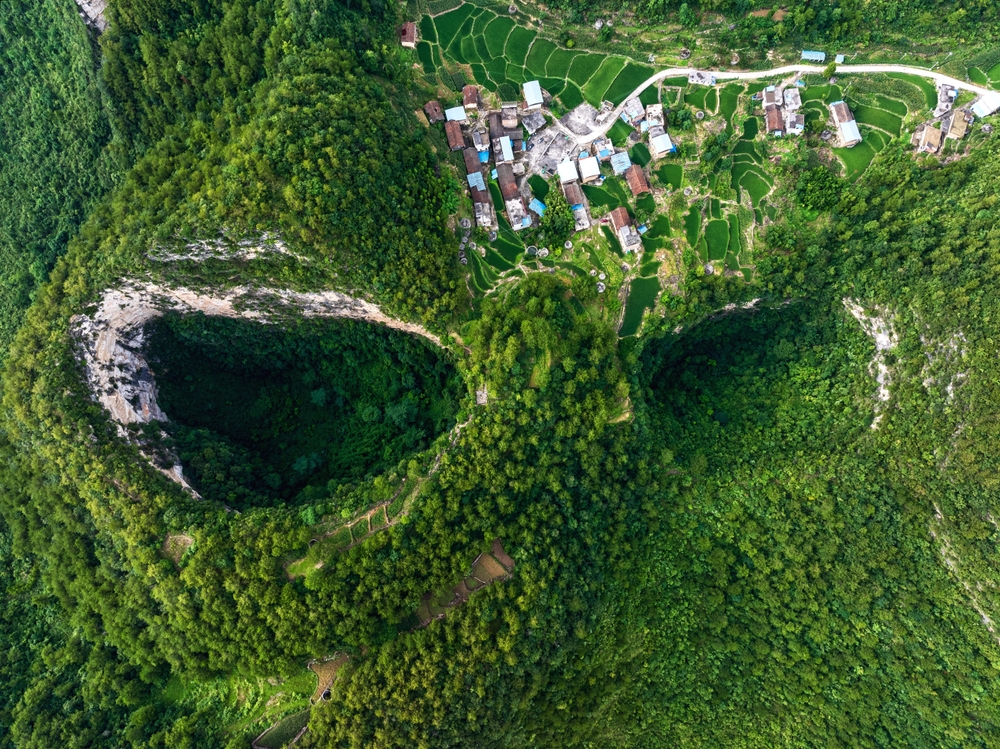China Has Discovered Underground Forests in Massive Sinkholes. These Ancient Ecosystems Have Been Found to Contain Rare Life That Developed in Isolation.

Beneath the surface of our planet, where light never touches, lies a world that has remained hidden for millions of years. Imagine stepping into a vast, ancient forest, untouched by time, thriving in the complete isolation of a colossal sinkhole. This is exactly what explorers in China stumbled upon—a discovery so extraordinary that it’s challenging the boundaries of what we know about Earth’s ecosystems.
These underground forests, concealed deep within sinkholes, have evolved in seclusion, harboring life forms that have developed in ways unimaginable to the outside world. But what makes this find so significant? What secrets do these forgotten realms hold, and what can they teach us about our planet’s past, present, and future?
What Lies Beneath

Sinkholes are nature’s way of reminding us of how much power lies beneath our feet. These are depressions or holes in the earth that form when the surface above a hidden void suddenly collapses. It all starts with something simple: water. As rain falls, it becomes slightly acidic and begins to erode the bedrock beneath the surface. Over time, this process slowly carves out tunnels and cavities in rocks like limestone. As these gaps grow larger, the earth above them becomes unstable, and eventually, it gives way—creating a sinkhole. What’s left is a raw reminder of nature’s ability to shape the world in ways we can’t always predict.
In places like southern China, where the landscape is dominated by karst topography, sinkholes aren’t just rare occurrences; they are a natural phenomenon that carves entire landscapes. Karst regions are shaped by the slow but relentless action of water, dissolving limestone and creating vast underground rivers, caves, and, of course, sinkholes. These formations are not only visually awe-inspiring but play a vital role in the ecosystem. In the Karst region of Guangxi Province, where the earth seems to fold in on itself, sinkholes have existed for millions of years, becoming homes to ecosystems few have ever seen or fully understood.
But it’s not just about their beauty. These sinkholes, particularly the giant ones, serve as time capsules, preserving life that has remained untouched by the outside world for centuries. The largest of them, known as “tiankeng” or “heavenly pits,” are immense—so vast, they seem like holes to another world. Some are over 600 feet deep, stretching far below the surface, and their isolated nature has allowed rare plant and animal species to develop in ways that defy everything we thought we knew about evolution. These sinkholes are not just geological wonders; they’re windows into the earth’s hidden past—preserving rare and irreplaceable ecosystems that remind us just how much there is still left to discover about the planet we call home.
Ancient Forests Within A Lost Ecosystem

The hidden forests inside massive sinkholes in China were not found overnight. These remarkable ecosystems are located deep within the Guangxi Zhuang Autonomous Region, in Leye County, an area famed for its extraordinary karst landscapes. These natural wonders—created over millions of years—are marked by steep limestone cliffs, towering rock formations, and, of course, sinkholes. In fact, Guangxi is home to some of the largest and most breathtaking sinkholes on the planet, a region that seems to be a cradle for geological miracles. The area has already yielded over 30 of these “heavenly pits,” and the most recent discovery has added even more intrigue to this mysterious land.
In one of these sinkholes, explorers stumbled upon an ancient forest unlike any other. The sinkhole, stretching more than 1,000 feet in length and 500 feet wide, plunges a staggering 630 feet into the earth. It’s a colossal, hidden world, perfectly preserved in time. Speleologists rappelled into this immense chasm and were greeted by towering trees that reach as high as 130 feet. This underground forest, covered by a thick carpet of undergrowth, had remained untouched by human activity for centuries. The isolation of this environment has allowed it to become a sanctuary for rare species of flora and fauna—species that have evolved in ways completely separate from the world above.
This discovery didn’t just add another page to the book of China’s geological wonders—it revealed a living snapshot of what the world may have looked like in ancient times. These ecosystems are more than just a curiosity; they are preserved pieces of natural history. The exploration team, who spent hours descending into the sinkhole, found that the forest floor was teeming with life—plants, insects, and even species of birds that had likely never been seen outside this isolated environment. For the first time, scientists and explorers alike were able to glimpse into an ecosystem that had been cut off from the rest of the world, a secret that had been hidden for millennia, waiting to be uncovered.
How These Ecosystems Evolved

The magic of these underground forests lies in their isolation. Sinkholes like the ones found in Guangxi create natural barriers that protect the ecosystems inside from the outside world. Cut off from the surrounding environment, these subterranean worlds evolve in ways that are unimaginable in the open air. The lack of human interference, the unique climate conditions, and the restricted access have allowed rare species to thrive in ways that they might never have in the broader ecosystem. Plants and animals that would otherwise have gone extinct are thriving in these hidden, untouched forests.
Over the years, this isolation has given rise to unique evolutionary traits in the species living within the sinkholes. The plants here are unlike any found on the surface, some with adaptations suited specifically to the cave-like environment. Wild orchids, previously thought to be extinct or extremely rare, are flourishing in these protected spaces. The dense undergrowth of the forest floor, which reaches as high as a person’s shoulder, is a testament to the vitality and resilience of this isolated ecosystem. But it’s not just the plants—animals have adapted in similarly fascinating ways. Cave-dwelling fish with translucent, ghostly white skin and unique species of insects have developed in isolation, evolving away from their surface-dwelling relatives.
What makes these ecosystems so remarkable is the simple fact that they exist in a world apart. In the surrounding forests of Guangxi, species are constantly exposed to the forces of climate change, human activity, and environmental disruption. But inside these sinkholes, time seems to stand still. They act as natural preserves, shelters for life that might have otherwise disappeared from the planet. Each new discovery within these ecosystems opens a window to the past, offering clues about how life can evolve and adapt when given the chance to thrive in isolation. These underground forests are nature’s treasure chest, a sanctuary for life that has managed to survive in a time capsule for centuries.
Earth’s Hidden Archives
These giant sinkholes offer more than just astonishing sights—they’re living geological records. Formed over millions of years, sinkholes hold vital clues to understanding the Earth’s history and environmental changes. Scientists studying the rock layers within these massive depressions can trace patterns of climate shifts, geological movements, and the evolution of natural ecosystems across vast spans of time. This makes the karst landscape of Guangxi not just visually remarkable, but scientifically invaluable as well.
Moreover, these sinkholes play a critical environmental role as natural reservoirs for groundwater. The karst aquifers beneath the surface provide essential freshwater resources for hundreds of millions of people worldwide. However, their porous nature means they’re vulnerable to contamination. Protecting these ecosystems is therefore not only about preserving unique biodiversity but also safeguarding clean water sources crucial for human survival.
Lastly, the discovery of such pristine ecosystems hidden deep beneath the surface provides a unique perspective on how isolated habitats react to environmental pressures. By studying how these forests have adapted over centuries without external interference, researchers can gain insights into resilience and adaptation strategies that might prove critical as our planet continues to face climate change and habitat disruption. In essence, these sinkholes are not merely geological wonders—they are keys to better understanding our environment and protecting our collective future.
Preserving These Hidden Treasures

While these underground forests are an extraordinary discovery, their unique ecosystems face growing threats, primarily from tourism and development. The very isolation that has allowed these ecosystems to thrive for centuries is now being challenged. As these sinkholes gain attention for their breathtaking beauty and the mysteries they hold, more visitors are flocking to the region. While tourism can provide economic benefits to local communities, it also brings significant risks. The fragile environments within these sinkholes are easily disturbed, and human activity—whether through direct interaction with the land or simply increased foot traffic—can alter the delicate balance that has existed for so long.
Overdevelopment poses another major concern. In some areas, large-scale infrastructure projects, such as viewing platforms and access roads, are already encroaching upon these protected sites. While these efforts are meant to enhance tourism, they risk harming the very ecosystems they aim to showcase. The introduction of pollutants, such as waste from tourists or construction activities, can damage the unique habitats within the sinkholes, potentially leading to the loss of rare species or irreversible changes in the landscape.
Conservationists and scientists are calling for a more sustainable approach to tourism and development. With the right regulations, it’s possible to protect these natural wonders while still allowing people to experience their awe-inspiring beauty. Sustainable tourism practices, such as using drones for aerial views instead of physical visits or limiting the number of tourists allowed to enter the sinkholes, could help preserve the integrity of these ecosystems. Striking a balance between economic growth and environmental protection is key to ensuring that these extraordinary environments remain intact for future generations.
A Call to Protect the Earth’s Hidden Wonders

The discovery of underground forests within massive sinkholes in China is more than just a scientific breakthrough—it’s a reminder of how little we truly understand about the natural world around us. These hidden ecosystems, which have thrived in isolation for centuries, hold secrets about life’s resilience and ability to adapt. Inside these ancient sinkholes, trees that tower high above the forest floor and rare species that have evolved in complete separation from the outside world tell a story of nature’s quiet strength. These forests are like time capsules, preserving life as it once was, untouched by the hand of humanity.
But here’s the reality: with every new discovery, there’s a responsibility to protect what’s been uncovered. As these sinkholes attract more tourists and developers, we face the challenge of finding a balance. Can we admire these wonders without disturbing their fragile balance? Can we protect what makes them unique while still allowing people to experience their beauty? The answer is yes—but it requires us to be conscious, intentional, and responsible with how we interact with nature. Sustainable tourism, careful planning, and limiting the impact of human activity are all necessary to ensure that these ecosystems remain intact.
These underground forests are a wake-up call for us all. They remind us that there are parts of this world still untouched, still pure, and still full of mysteries waiting to be uncovered. But they also serve as a powerful reminder of the importance of preservation. If we don’t take action now, these wonders could disappear before we even fully understand them. It’s up to us to protect the hidden gems of our planet—before they are lost to time, just like so many other natural wonders that were once here but are now gone.
Featured Image Source: Shutterstock
Loading...






